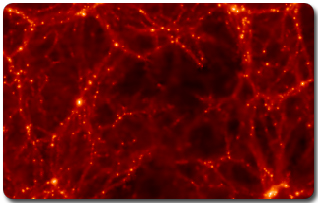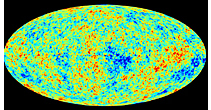 |
||
|
Ripples in Space: |
||
|
One of the fundamental mysteries that we encounter in modern cosmology is the origin of the structures we observe in the sky today. Examples of the larger astronomical objects presently observable are: galaxies and clusters of galaxies, the large 'voids' in which galaxies seem to be lacking, and the 'great walls' with a higher than average density of galaxies. While more traditional astronomy clarifies the detailed nature of these objects, the goal of cosmology is to understand the physical origin and evolution of the Universe on the largest scales, and how these objects came into existence. Einsteinian gravitation provides the theoretical basis for describing currently accepted cosmological scenarios. Coupled with certain key observations such as the Hubble expansion, we have used this general theory to create an outline of the major events in the history of the Universe. In particular, there is an initial event in which everything in the Universe is compressed into a very small region. From this region, the Universe expanded to become what it is today. This initial event can reasonably be defined as the 'birth' of the Universe since, at that epoch, the Universe was so hot and dense that information from any previous existence would have been erased. These physical conditions, and the subsequent rapid expansion, are called the 'Big Bang'. The existence of the Big Bang also defines the age of the Universe as the elapsed time since the event. We now know the age of the universe to be 13.7 billion years. According to the standard scenarios, the objects that astronomers study have only been in existence for the past 5 billion years. What happened in all that time between the Big Bang and the emergence of stars and galaxies? Is there a way to explain the distribution of mass in the Universe in terms of more fundamental physics? These are some of the challenges of modern cosmology.
The Cosmic Microwave Background Radiation (CMBR), discovered in 1964, is a glow in the sky in the microwave and far-infrared region of the electromagnetic spectrum (wavelengths of about 1 to 10 mm) which has a distribution of energy with wavelength that is typical of a system in thermal equilibrium. It was quickly established that the intensity of the CMB with position in the sky is extremely uniform, exceeding the sensitivity of the early instruments that probed this uniformity at the 1% and 0.1% levels. Since that time, cosmologists have realized that measuring the angular variations, or anisotropy, in this radiation would provide important clues to why matter is distributed the way it is today. Variations in density in the universe lead to ripples in space-time and thus to anisotropies in the cosmic microwave background. Imagine an extremely hot and dense Universe right at the initial moments of the Big Bang. The physical conditions are so far beyond currently understood physics that we cannot really describe the details of physical processes at that time. As the Universe expands and thus cools off (within the first second), the density and temperature decrease sufficiently that we start to enter the regime of high-energy physics theory. Although the Universe is so hot that most common forms of matter are still in an undifferentiated state that resembles a 'soup' of pure thermal energy, some elementary particles (e.g., protons, neutrons) eventually condense out of this soup and become stable. As the cooling continues, atomic nuclei become stable and the light elements form. The rapid expansion of the Universe (along with the high density of photons) limited the formation of heavier elements at that time. The expansion and cooling continue and eventually, electrons bind with protons to form neutral hydrogen atoms. This happens when the Universe is approximately 300,000 years old. The critical event for this epoch is that photons (light), a major and dominant constituent of the primordial soup, start to propagate independently of the matter in the Universe. During earlier times, the free electrons and protons interact strongly with the photons so they are, in a sense, all scrambled together in a cosmic soup. After the electrons bind with the protons to make neutral hydrogen (and the other light elements), the Universe becomes transparent to light, allowing the photons to propagate freely. For this reason, we call that epoch the era of decoupling (of matter from light). Because all the constituents (particles and radiation) in the early Universe interact strongly among themselves, they are in thermal equilibrium that means the light intensity at each wavelength (or frequency) is predictable. The shape of intensity with frequency or wavelength is called the spectrum. For thermal equilibrium the radiation spectrum has a simply calculable shape first shown in 1900 by Max Planck, which is the characteristic shape given by a perfectly absorbing (and thus black) object. The thermal spectrum shape is called a blackbody. As the Universe cools, the shape of this spectrum changes in a special way that maintains the characteristic shape of a blackbody at cooler and cooler temperatures. We observe that the photons in the CMBR today have a distribution characteristic of 3 Kelvin (2.73K), and knowing that hydrogen atoms are stable at temperatures below about 3000 Kelvin, we can predict that the epoch of decoupling occurred when the universe became neutral. When we study the distribution of intensity of the CMBR in the sky, we are actually looking at the distribution of matter and radiation during the era of decoupling. This is like looking through a transparent Universe back to the time of decoupling, in which the Universe was opaque like a dense fog. By studying the bright and dark spots of the radiation, we infer the pattern on the surface of the fog. In the case of the CMBR, the pattern is the distribution of matter. The regions that are slightly more dense than others gravitationally attract the photons, causing them to lose some energy in transition. These regions thus appear to be at a lower temperature. Those regions that are less dense have less of this effect, and the radiation appears to be at a relatively higher temperature. There is one complication to this entire scenario that has only recently been explained. At each instant in the history of the Universe, there is a characteristic 'radius' of the Universe that is set by the distance that light could have traveled. Thus, if the Universe were only one second old, then we could not see things that are more than 300,000 kilometers away - there has simply not been enough time for this light to reach us. Since no observer can see beyond this distance, the surface at this distance is also called the 'horizon' for the observer. As the Universe ages, the horizon expands outward because there is more time for distant light to travel to us. An important side effect is that if we cannot see beyond the horizon, then neither can we be affected by any physical effect from beyond the horizon. Regions of space in the Universe that are separated in distance by more than the horizon simply cannot influence each others physical conditions. If we calculate the size of the horizon in the sky for the Universe at the epoch of decoupling, it turns out to be approximately one degree (about twice the angular diameter of the Moon). The fact that the spectrum and intensity of the CMBR are essentially the same for regions much larger than this size is difficult to explain. Our scenario does not allow these regions to communicate with each other and thus conspire to determine their physical characteristics. A solution to this dilemma was found in the early 1980's and is called inflation theory. The concept, motivated by a merging of high-energy particle physics theory with cosmology, is that within the first 10-34 seconds of the Big Bang, the Universe went through a period of extremely rapid expansion. This causes our entire Universe to be derived from a very small region of space (before inflation). Because it was such a small region, it would have very uniform properties and its constituent parts could indeed communicate with each other. Thus, when we observe the CMBR from parts of the sky that are separated by more than one degree, the intensity variations are those imposed by the conditions in the pre-inflationary era - when the Universe was less than 10-34 seconds old! After inflation, there is simply no way for physical processes to modify these variations. At angular sizes less than one degree, however, there has been sufficient time for physical interactions to modify the intensity of the CMBR at the epoch of decoupling, and the resulting variations in intensity depend on the details of the theory of such interactions. NASA's COBE satellite made some very fundamental measurements of the CMBR. The FIRAS instrument determined that the spectrum matches the theoretical curve for thermal equilibrium to within 0.03%, lending unequivocal support to the Big Bang scenario, and confirming the belief that the early Universe was indeed in thermal equilibrium. The COBE/DMR instrument measured the anisotropy of the CMBR and made the first detection of the variations of CMBR intensity at the level of one part in 100,000 of the CMBR intensity. Both of these instruments have a beam size of 7-degrees, which means that they can only see structures that are larger than about 14 Moon diameters in the sky. As noted above, any anisotropy measurement at resolutions coarser than one degree will probe the fundamental fluctuations from the pre-inflation era, but could not possibly be the result of any interactions at a later time. Theory is used to relate these measurements directly to modern structures. The reason is that when we look at 7-degree size for a source at the distance of the era of decoupling, it corresponds to a size (after expanding by a factor of 1000) larger than the largest of structures that we can see in the Universe today. The scale sizes on which we have data for the Universe today correspond to patches of only about a half-degree when we look back at the decoupling epoch. Thus, in order to relate the observed CMBR anisotropy to the structures that we see today (which are, in a sense, today's anisotropy), it is convenient to have measurements on smaller angular scales than COBE/DMR. Many groups and collaborations worked on balloon-borne, ground-based and proposed satellite measurements of the CMBR anisotropy on angular scales between 0.1 and 3 degrees. On the Smoot Group page you can read about the COBE satellite and its instruments, the MAX/MAXIMA/BOOMERANG balloon-borne instruments, and the Planck satellite (formerly known as the COBRAS/SAMBA) which is now a European Space Agency mission. With the COBE/DMR discovery, the required sensitivity level has been established. Theorists have worked hard to determine what can be learned from precise CMBR anisotropy measurements and have found they can provide important and precise information on a number of crucial cosmological parameters, e.g. the geometry of the universe, the Hubble expansion rate, the density in baryons, the cosmological constant, and for inflation - the potentials slope, energy level, and curvature. With these observations, we have entered a measurement and characterization phase during which the smaller angular scales will be crucial to uncovering the mystery of the origin of structure in the Universe. |
||

